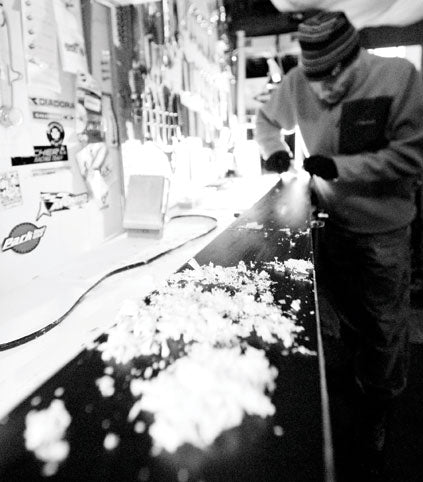By Mark Ollinger
Originally published on MountainGazette.com in 2010. Republished here for readers of our Sunday email newsletter.
It has been demonstrated that our brains are divided into two distinct halves or hemispheres. The theory is that each hemisphere of our brain controls different modes of thinking. The left side of our brain is logical, objective and likes to dissect objects into the parts that make them up. The right side of our brain is intuitive, subjective and looks at whole entities. Most of us prefer, or are more comfortable with, one mode of thinking over the other.
This distinction, along with a number of other philosophical issues, was addressed in the 1970s bestseller “Zen and the Art of Motorcycle Maintenance: An Inquiry into Values” (ZMM), by Robert Pirsig. The book chronicles a cross-country motorcycle trip with the narrator (presumably the author), his son Chris and two friends named John and Sylvia. Pirsig uses this road trip as a backdrop to examine values, quality and an insane man’s search for his past. I first read the book a long time ago and one of these days I hope to understand some of it. I’m not that deep, and it was a tough read for me. Based on some of the reviews of book posted on Amazon, I am not alone.
One theme in ZMM was the dichotomy between what Pirsig referred to as classical thinking and romantic thinking. Pirsig felt there were two types of understanding. The classical thinkers are like engineers who break things into smaller logical units and want to know the mechanical aspect of how things work. The narrator was a right-brained classical thinker who liked to work on his motorcycle almost as much as he liked to ride it. Romantic thinkers, on the other hand, are more like artists concerned with the whole and the appearance of things. The romantics, John and Sylvia, loved the riding experience, but were clueless as to how their machines worked. The narrator took great pride in being able to create a “band-aid” solution to a mechanical problem with his motorcycle. John did not like any solution that detracted from the clean aesthetic appearance of his fine road machine. The narrator’s bike was a practical Honda, while John and Sylvia had a stylin’ BMW status bike.
In ZMM, Pirsig pointed out the problems that arise when people remain stuck in one mode of thinking to the exclusion of the other. Some of the conflicts on the trip stemmed from the right-brained narrator’s orientation and his left-brained travel companions.
As I see it, cross-country skiing faces a similar split-personality. When you are out skiing with good snow and correctly waxed skis, it is easy to take a romantic view of the world. It is hard to beat the rhythm, beauty and the exhilaration of skiing on a crisp sunny day. The air is fresh and invigorating. Cares and concerns seem to melt away. The right side of the brain is in charge all of the way.
In contrast to cross-country skiing, ski waxing is rooted in the classic view of the world. In order to make the experience seem effortless, you need to get the wax right. This is where the devil is in the details. Here is where you need to think about such mundane technicalities as temperature, age of the snow, trail conditions and waxing techniques. If you don’t, you’ll be slipping or the skis will clump up with snow. To avoid this, you need to spend time in your basement waxing, scraping and corking. The more time you spend in this left-brain mode beforehand, the better your right-brain experience on the trail.
Our left brain is in charge when we are waxing our skis. It is asking black-and-white questions like: What is the temperature of the snow? When did it last snow? Has the snow melted and refrozen? What is the correct kick wax to apply in this situation? When we are out skiing, our right brain seems to take charge. The questions seem to be more subjective. How do I feel? Isn’t the air fresh? Why don’t I do this more often? As skiers, we have to embrace both ways of thinking.
I see some of this difference between myself and my brother Michael. I would place Michael in the rightbrained romantic camp. He has always been more artistic than I am. He’s a big-picture guy, while I’m the anal-retentive one. Drawing and art come easily to him, while I struggle with doodling stick people. We both have the same brand of skis. He fi nds the color and graphics on the skis dull and boring. I guess I never noticed.
When it comes to cross-country ski waxing, I refer to him as the “waxing agnostic.” He knows that the proper kick wax is required for the ski to work well, but he is quite content to con me into waxing his skis for him. As a nit-picky accountant, I want to know how this stuff works. I have made several trips to the library and the bookstore to read about the various types of kick-and-glide wax that I should have in my kit. I was amazed at the amount of detail that some of the authorities on the subject go into. I learned more about snow crystals than I ever thought I would. I still suffer from feelings of inadequacy when it comes to waxing. Michael is unburdened by his waxing ignorance.
ZMM also deals with the narrator’s battle with insanity. Earlier in his life, he had undergone electro- shock therapy. He refers to his alter-ego before therapy as “Phaedrus.” From the outsider’s view, cross-country ski waxing seems to have an element of insanity. Most articles on glide waxing emphasize that you can’t glide wax your skis enough. As a result, we spend a great amount of time melting and ironing in the glide wax, only to scrap it all off. And then we start all over again. It does strike one as being a bit obsessive/compulsive. This “wax-on”/“wax-off” process is a puzzle to the non-skiing members of my family. They are convinced that the wax fumes have gotten to me. And then there is the issue of our wax kits. We collect a number of different sticks of wax, tubes of klister, brushes and scrapers. We store this collection in a neat little tackle box. Isn’t this a bit anal-retentive? Sigmund Freud would have a field day with us. One solution would seem to be waxless cross-country skis. Once again, contradictions abound. “Waxless” is a bit of a misnomer, as you still need to do a little bit of glide-waxing from time to time. If ZMM’s John and Sylvia, were cross-country skiers, I’d bet they own waxless skis with really great graphics.
It’s all a question of balance. To have the best time skiing, we need to engage both sides of our brain. We need to sweat the details, but still absorb the whole experience. We need to be both the diligent ant and the fun-loving grasshopper. Does that make us schizophrenic like the narrator of ZMM? I don’t know. I can’t make up my mind.
Mark Ollinger enjoys mountain biking and cross-country skiing in elevation- and snow-challenged Barrington, Illinois. While he tries to figure out what to do when he grows up, Mark serves as chief financial officer at a trade-show marketing company.
















